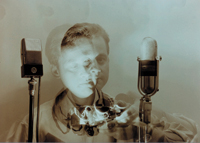
This is a FLAT 2-dimensional time-lapse picture,
come see 3D pictures at the exhibit!
EXPLORATIONS OF THE
THIRD DIMENSION
3-D stereoscopic images of the past and present
We see in 3D, so does a two-lens camera

EXPLORATIONS OF THE
THIRD DIMENSION
3-D stereoscopic images of the past and present
We see in 3D, so does a two-lens camera
At least 85-90% of human perception is acquired through the eyes.Because we have two eyes, we perceive not only height and width, but depth as well. Each eye sees the world from a slightly different vantage point, allowing us to perceive the relationship of objects to one another in space. Most photographs are flat, or two-dimensional, showing only the relationship of the height and width of objects.
To create the third-dimension, which adds the perception of depth, a pair of images is required, not just a single image. So a camera with two lenses, set apart a distance comparable to our average eye spacing, is required. Those two lenses can produce a stereo pair with the left image being from a different point of perspective than the right image.
To view the left and right image pair recorded by the two lens camera, a viewing system is require to let the left eye see the left image and the right eye to see the right image. The result is that each eye sees one of those two discrete images, and sends the information to your brain. Then, your brain processes the two images, allowing you to see one solid 3D stereoscopic image. This phenomenon is called stereopsis.
|
|
|
|
Gleason
Public Library
22 Bedford Road (Route 225)
Carlisle, MA 01741
978-369-4898
Library Hours: Mon., Tues.,
Thurs., 10 a.m. - 9 p.m.
Wed., 1:00 p.m. - 9 p.m.
Fri., Sat., 10 a.m. - 5 p.m.